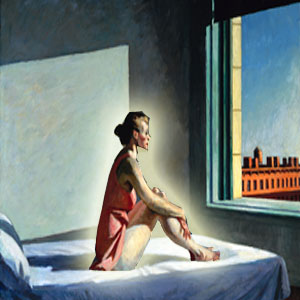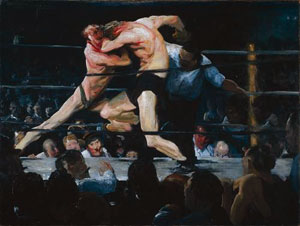
THE ROARING TWENTIES
The two artists prominent during 1920-1929 were Edward Hopper and George Bellows. They were completely different people with their own style of art. Artists during this time period experienced many difficulties in their careers. 
Edward Hopper was born in the small seafaring town of Nyack, New York on July 22, 1882. He was born into a middle class family and his father was a local businessman who owned a dry goods store in Nyack. Hopper wanted to pursue a career in fine arts after graduating from his high school. His parents, however, did not agree with his decision and wanted him to go to the correspondence school of illustrating in NYC. He did what his parents expected from him but he hated doing it. Even though he was pursuing a career in illustration he always had art in the back of his head. From the 18 th century through the early 20 th century, every American artist wanted to go to Europe. Hopper also went to Europe and stayed in Paris where his former classmate, Patrick Henry, introduced him to the French impressionists like Sisley, Renoir and Disarro. After meeting these artists, he was both intrigued as well as impressed by their work. He began experimenting with an impressionist style as well as pointillism. After 1910, he settled in New York and New England and was forced to support himself as a commercial illustrator. Martin Lewis introduced etching technique to Hopper. Etching suited hoppers background in illustration as well as his love of contrast. Hopper produced dozens of etchings between 1915 and 1923. He at last felt secure enough to give up his commercial work and concentrate on painting full-time. Hopper liked to watch people, but more importantly, he liked to watch then without being seen.
George Bellows, on the other hand, was born in august 19 th , 1882.  His style of artwork was his bold depictions of urban like in New York City. Bellows first achieved notice in 1908, when he and his fellow friend Henri organized an exhibition of mostly urban studies. He executed a series of paintings depicting New York City under snowfall. His series of painting portraying amateur boxing matches were arguably his signature contribution to art history. His paintings are characterized by dark atmospheres, through which the bright roughly lain brushstrokes of the human figures vividly strikes with a strong sense of motion and direction.
His style of artwork was his bold depictions of urban like in New York City. Bellows first achieved notice in 1908, when he and his fellow friend Henri organized an exhibition of mostly urban studies. He executed a series of paintings depicting New York City under snowfall. His series of painting portraying amateur boxing matches were arguably his signature contribution to art history. His paintings are characterized by dark atmospheres, through which the bright roughly lain brushstrokes of the human figures vividly strikes with a strong sense of motion and direction.
Edward Hopper won numerous prizes, gaining the recognition as an etcher. In November of 1924, he exhibited eleven watercolors at the Frank K.M. Rehn gallery in NY. He sold every painting, plus an addition five. Although he is considered a realist, the meaning of his paintings goes much deeper than just the surface of the canvas. Hopper had his own message to convey and that was his state of mind and the fact that the only person he was after was himself. As he said "I m after me". In 1964, illness briefly stopped him from working. The following year, at the age of 83, he painted "Two comedians", his farewell to the world. His other works also includes paintings such as Nighthawks, 1942, Soir Bleu, 1914 and Girl at Sewing Machine, 1921. Edward Hopper died in 1967. The second artist, George Bellows, is also known for his artwork such as Cliff Dwellers (1913), Both members of this club (1909) and Shore House Date (1911). He was also a very successful artist of that time. George Bellows died on January 8, 1925.
Both artists went through many obstacles in their life to get to their destination. They had to work very hard to find their true passion and their style. Edward Hopper supported himself by doing something he hated to pursue his art career. They used art as the means to approach their audience and portray themselves in their eyes.
BOOK SOURCES
- Foe, Emma. Artist in their time :Edward Hopper. Scholastic Library Publishing.2003.
- Doss, Erika. " Twentieth Century American Art ". Great Clarendon Street, Oxford. Oxford University Press, 2002.
INTERNET SOURCES
- "George Bellows." "www.google.com."23 Jan , 2008.<http://cache.eb.com/eb/image?id=13158&rendTypeId=4>
- "www.google.com". 24 Jan , 2008. <http://graphics8.nytimes.com/images/2007/05/04/arts/04hopp_CA2.600.jpg>
- Berkow, Ita G. Edward Hopper:A modern master. New Line Books , Sep 1 2005.